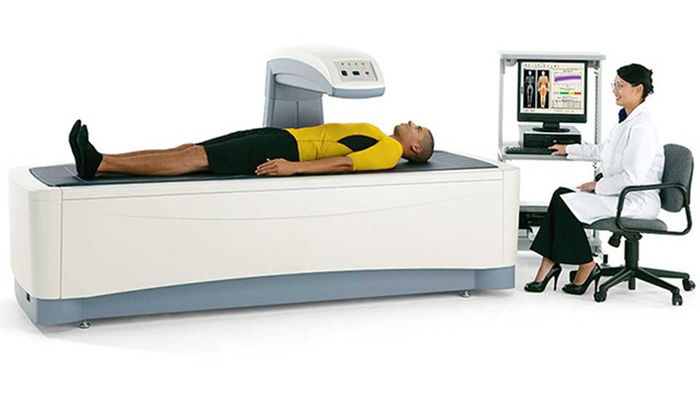Gurmeet Imaging
DEXA

Dual-energy X-ray absorptiometry is a means of measuring bone mineral density (BMD. Two X-ray beams, with different energy levels, are aimed at the patient’s bones. When soft tissue absorption is subtracted out, the BMD can be determined from the absorption of each beam by bone. Dual-energy X-ray absorptiometry is the most widely used and most thoroughly studied bone density measurement technology.
The DXA scan is typically used to diagnose and follow osteoporosis, as contrasted to the nuclear bone scan, which is sensitive to certain metabolic diseases of bones in which bones are attempting to heal from infections, fractures, or tumors.
How does the procedure works?
In the central DEXA examination, which measures bone density in the hip and spine, the patient lies on a padded table. An x-ray generator is located below the patient and an imaging device, or detector, is positioned above.
To assess the spine, the patient’s legs are supported on a padded box to flatten the pelvis and lower spine. To assess the hip, the patient’s foot is placed in a brace that rotates the hip inward. In both cases, the detector is slowly passed over the area, generating images on a computer monitor.
The peripheral tests are simpler. The finger, hand, forearm or foot is placed in a small device that obtains a bone density reading with a few minutes.
An additional procedure called Lateral Vertebral Assessment is now being done at many centers. LVA is a low dose x-ray examination of the spine to screen for vertebral fractures that is performed on the DEXA machine.
The DEXA machine sends a thin, invisible beam of low-dose x-rays with two distinct energy peaks through the bones being examined. One peak is absorbed mainly by soft tissue and the other by bone. The soft tissue amount can be subtracted from the total and what remains is a patient’s bone mineral density.
DEXA machines feature special software that compute and display the bone density measurements on a computer monitor.
We are Committed to
Excellence in diagnostic care
We have experienced as well as highly qualified doctor's. Therefor we have excellent Diagnose Care.
Reporting & Supports
Most of the larger laboratories have fully automated equipment and quality and statistical analyses are run daily on them.
Computerised Equipments
We believe in latest and advanced technology so that we get accurate result's. We have fully computerized equipment's.
